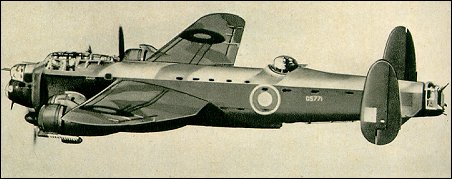 |
Avro 683 Lancaster1941 |  |
| BOMBER | Virtual Aircraft Museum / United Kingdom / Avro |
 |
Most famous of all Avro military aircraft and without doubt the most successful heavy night bomber to be deployed over Europe during World War II. The Avro 683 evolved almost accidentally as a result of recurrent failure of the insufficiently developed Rolls-Royce Vulture engines installed in the twin-engined Avro Manchester. Owing to delays in the full development of the Vulture engine, the decision was taken in mid-1940 to design a new version of the Manchester with four Rolls-Royce Merlin engines. The first conversion made use of about 75 per cent of the Manchester's parts and assemblies, the principal change being the provision of a new centre-section of the wing with mountings for Merlin engines. This aeroplane became the first prototype of the Lancaster. A second prototype fitted with Merlins and significantly modified in detail was designed, built and flown in just eight months. The first production Lancaster I flew just over five months later, its power plant comprising similar 954kW Rolls-Royce Merlin XX in-line liquid-cooled engines, each driving a three-blade constant-speed and fully feathering propeller. Because of the possibility of some interruption in Merlin production, the Lancaster II was built with 1,229.5kW Bristol Hercules VI radial engines. These fears did not materialise, with the result that only 300 Lancaster IIs were built. First operational RAF squadron to be equipped with Lancasters was No 44, which used them operationally for the first time on 3 March 1942 - laying mines in the Heligoland Bight. Defended by ten machine-guns and carrying a maximum bomb load of 6,350kg, the Lancaster was - and soon proved itself to be - a formidable weapon in the hands of the RAF, which had, by mid-1942, learned a great deal about night bombing operations over Europe. By comparison with contemporary four-engined bombers it was statistically the most effective, dropping 132 tons of bombs for each aircraft lost on operations; the corresponding figure for the Halifax and Stirling were 56 and 41 tons respectively. The Lancaster was so right, from the beginning, that there were very few changes in airframe design during its wartime service. Improved power plants, however, provided steadily improving performance: the Lancaster VII, for example, with 1,207kW Merlin 24 engines, had a maximum take-off weight of 30,844kg by comparison with the 22,680kg of the early Lancaster I. Bomb load changed considerably, the cavernous bomb bay being designed originally to carry bombs of up to 1800kg, with a total bomb load of 6,350kg; it was modified progressively to carry the 9,980kg Grand Slam bomb. The Lancaster will be remembered for its part in two spectacular operations: the breaching of the Mohne and Eder dams on the night of 16-17 May 1943 by No 617 Squadron (led by Wing Cdr Guy Gibson); and the sinking of the German battleship Tirpitz. Its contribution to victory in World War II is best measured, however, by the total of 608,612 tons of bombs delivered, which represented two-thirds of the total bomb load dropped by the RAF from the time of its entry into service. A total of 7,366 Lancasters were built (including Mk X in Canada) and the type remained in front-line service with the RAF until 1954. Canada had some photo-reconnaissance Lancasters in service in 1964.

|  COMPANY PROFILE | |||||||||||||||||||||||||||||||||||||||||||||||||||||||||||||||
 |

|

